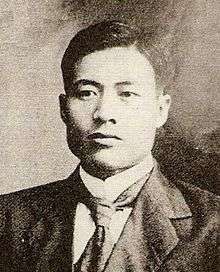Chiang Wei-shui
| Chiang Wei-shui | |||||||||||||||||||||||||||||||||
|---|---|---|---|---|---|---|---|---|---|---|---|---|---|---|---|---|---|---|---|---|---|---|---|---|---|---|---|---|---|---|---|---|---|
 | |||||||||||||||||||||||||||||||||
| Born |
February 8, 1891 Gilan District (modern-day Yilan County), Taipeh Prefecture, Taiwan, Qing Dynasty | ||||||||||||||||||||||||||||||||
| Died | August 5, 1931 (aged 40) | ||||||||||||||||||||||||||||||||
| Known for | Founding the Taiwanese Cultural Association and the Taiwanese People's Party | ||||||||||||||||||||||||||||||||
| |||||||||||||||||||||||||||||||||
Chiang Wei-shui (Chinese: 蔣渭水; Pe̍h-ōe-jī: Chiúⁿ Ūi-súi; February 8, 1891—August 5, 1931) was a founder of the Taiwanese Cultural Association and the Taiwanese People's Party. He is seen as one of the most important figures in Taiwan's resistance movement against Japanese rule.
He once wrote a short essay on Taiwan called Bedside Examination (臨床講義) about how the patient (Taiwan) suffered from severe culture malnutrition. Written in the form of a medical examination, it is his most famous work.
Biography
Chiang was born in Yilan during the Qing Dynasty rule. At the age of 10 he began to study with a Confucian scholar (張鏡光). In 1915 he graduated from the Taiwan Medical College, now the National Taiwan University College of Medicine.
He founded the Taian Hospital (大安醫院)[1] in Daitōtei, a district in modern-day Taipei, and invited fellow intellectuals to the hospital to discuss contemporary affairs. In 1920 he began participating in the movement to found the Taiwan Assembly. In 1921 he helped found the Taiwan Cultural Association. He was imprisoned for four months in 1923 and again in 1925 for his opposition to the Japanese colonial government. In total, he was imprisoned more than ten times.
In 1927, the Taiwan Cultural Association split because of an internal ideological division between rightists and leftists. Chiang went on to help found the Taiwanese People's Party on a platform of unity. The Taiwan People's Party was the first legal party to be founded in Taiwan. Chiang was also involved with the Taiwanese Worker's League and the Taiwanese Farmer's Association (台灣農民協會). He came under criticism from rightists in the government. When Chhoà Pôe-hóe, Ia̍p Êng-cheng and others prepared for the formation of the Taiwan Local Self-Government League, Chiang expelled them. The Taiwan People's Party contacted the League of Nations several times to protest Japanese issuance of special permits for opium sale as well as the Wushe Incident.
The Taiwanese People's Party's political philosophy was the Three Principles of the People, but Hsieh Chun-Mu and others pushed for a revolutionary line. In 1931, the colonial administration forced the dissolution of the party. Chiang died of typhoid that same year, at the age of 40 (41 by traditional Chinese reckoning).
Writing in the 1970s in the context of the nativist and Tangwai movements, Democratic Progressive Party legislator Huang Huang-hsiung described Chiang as Taiwan's Sun Yat-sen.
His grave was located in Taipei Public Cemetery No. 6, on Chongde St., near Liuzhangli Station, until October 2015, when his remains were moved to Cherry Blossom Cemetery in Yilan.[2]
Legacy
A 12.9 kilometres (8.0 mi) freeway tunnel passing under Xueshan to link Taipei with Yilan was opened in 2006.[3] It marked the completion of Taiwan's latest freeway, which was subsequently named the Chiang Wei-shui Freeway in a move that pleased all sides of the political spectrum in Taiwan.
Currently, his likeness is featured on the 10 NT coin in Taiwan.[4]
References
- ↑ http://dadaochen.ylps.tp.edu.tw/upload/justwarp/images/%E5%9C%96%E4%BA%8C%20%E6%98%94%E6%97%A5%E7%9A%84%E5%A4%A7%E5%AE%89%E9%86%AB%E9%99%A2%281%29.bmp in http://dadaochen.ylps.tp.edu.tw/content.php?titlename=hospital&output_menu=true
- ↑ Chien, Hui-ju; Chin, Jonathan (6 October 2015). "Democracy pioneer Chiang Wei-shui's ashes return to Yilan". Taipei Times. p. 3. Retrieved 6 October 2015.
- ↑ Chuang, Jimmy (15 Jun 2006). "Taipei-Ilan freeway named in honor of democracy pioneer". Taipei Times. p. 2. Retrieved 2010-09-29.
- ↑ "Announcement: issue a NT$10 coin in memory of Mr. Chiang Wei-shui on 5th August 2010". Central Bank of Republic of China(Taiwan). 2010. Retrieved 2010-09-29.
External links
- Taiwan Panorama Magazine:Nationalist Pioneer Chiang Wei-shui
- Taiwan Yearbook: Land Transportation, Chiang Wei-shui Freeway
- Theatre Production: The Impossible Times: Chiang Wei-shui